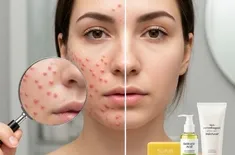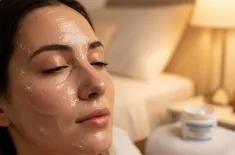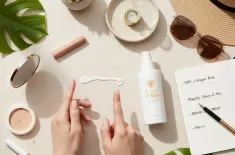Master the viral depuffing technique! Use this gua sha tutorial for facial lymphatic drainage, reducing morning puffiness, sculpting your face
In the pursuit of radiant, clear, and sculpted skin, many people turn to high-end serums, advanced devices, and complex skincare routines. However, one of the most powerful, yet simplest, beauty rituals is rooted in an ancient practice: lymphatic drainage massage. This gentle, rhythmic technique is not just a passing trend; it's a vital self-care practice that supports the body's natural detoxification process, leading to a visibly brighter and more sculpting face.
This comprehensive guide will walk you through the science of the lymphatic system and provide a simple, effective at-home routine using your hands or a gua sha tutorial to achieve an instant depuffing technique, tackling issues like morning puffiness and persistent fluid buildup.
Understanding the Lymphatic System and Its Role in Skin Health
The lymphatic system is often called the body's "sewerage system." It is a vast network of tissues, vessels, and organs that work together to move a clear fluid called lymph back into your circulatory system.
What is Lymph and Why Does it Matter?
Lymph fluid is essential for immune function and waste removal. It collects cellular waste, toxins, bacteria, and excess fluid from the body's tissues. Unlike the circulatory system, which has the heart to pump blood, the lymphatic system has no central pump. It relies on muscle movement, breathing, and manual stimulation to circulate.
When the lymph flow is sluggish—due to stress, lack of movement, diet, or illness—waste and fluid can accumulate, leading to inflammation, dull skin, breakouts, and, most commonly, visible swelling or puffiness, especially in the face and neck. A consistent at-home lymphatic drainage massage routine is crucial for reducing fluid retention and keeping this system flowing efficiently.
The Magic of Facial Lymphatic Drainage
The skin on your face, particularly around the eyes and jawline, is very thin and sensitive, making fluid accumulation quickly apparent. By performing facial lymphatic drainage, you are gently coaxing the stagnant lymph fluid from the superficial tissues and guiding it towards the lymph nodes, where the waste is filtered and eliminated. The immediate result is a clearer complexion, reduced under-eye bags, and a more defined facial contour.
The Viral Depuffing Technique: Step-by-Step Tutorial
This simple, viral step-by-step tutorial using hands or a gua sha tool is designed to promote lymph flow, focusing on the neck and jawline for an instant depuffing effect. Always begin on clean skin with a generous layer of facial oil or serum to ensure your movements glide smoothly and never pull or tug at the skin.
Phase 1: Opening the Lymph Channels (The Prep)
Before moving the fluid, you must gently signal the "drainage points" or lymph nodes to open up. Think of these as the main exits for the collected waste.
Clavicle Pumping (Start & Finish Point): Place your index and middle fingers right above your collarbones (clavicles). Apply very light pressure—the weight of a nickel is often cited—and gently pump 5-10 times. This area houses the terminus of the entire drainage path, where the lymph re-enters the bloodstream.
Neck Node Activation: Place your fingers behind your ears, where the neck meets the skull (occipital nodes). Gently press and release 5 times. Move down to the side of your neck, just below your earlobe (parotid/cervical nodes), and repeat the gentle press/release 5 times.
Chest Sweep: Use a broad hand or the flat edge of a gua sha tool to sweep down the chest from the center out towards the shoulders and down towards the clavicle, 3 times per side.
Phase 2: Draining the Face (The Sweep)
All movements on the face must be light and always directed down and out towards the nearest lymph nodes—ending at the neck or clavicle. Repeat each movement 3-5 times.
Tackling Morning Puffiness (Eyes): Use your ring finger (the lightest pressure) or the curved notch of the gua sha. Start at the inner corner of the under-eye area and gently glide outwards towards the temples. Do not drag the skin. From the temples, continue the light glide down the side of the face to the ear.
Forehead Fluid: Using the flat edge of your gua sha or two fingers, sweep from the center of the forehead outwards toward the temples.
Cheeks and Nasal Area: This is key for sinus relief and central facial puffiness. Use the large curve of the gua sha or your knuckles. Start next to the nose and sweep outward along the cheekbone towards the ear.
Jawline Sculpting Face: This is where the most visible depuffing technique takes place. Use the "v" or notched end of your gua sha tool, or your knuckles, to hug the jawline. Start at the center of the chin and sweep firmly (but not painfully) along the bottom of the jawbone, gliding all the way up to the earlobe.
Finishing the Gua Sha Tutorial: Collect all the fluid. Use the flat side of the gua sha or a full hand. Starting from the ear, sweep down the side of the neck to the clavicle (the start/end point). This final sweep guides the collected fluid down for elimination.
Advanced Tips for Maximizing Results
While the core movements are simple, integrating these advanced tips will amplify the depuffing technique and maximize the long-term benefits of your facial lymphatic drainage.
The Importance of Hydration and Diet
Lymph is primarily water, so staying properly hydrated is critical for ensuring the fluid is thin and moves easily. If you are dehydrated, your lymph can become thick and sluggish.
- Drink Water: Start your day with a large glass of water, perhaps with lemon, which can aid in digestion and detoxification.
- Reduce Inflammatory Foods: High-sodium, processed foods, and excessive alcohol are major contributors to fluid retention and morning puffiness. Reducing fluid retention starts in the kitchen.
Breathing Deeply (Abdominal Respiration)
As the lymphatic system has no pump, deep, diaphragmatic breathing is one of the most effective ways to move lymph throughout the body. The diaphragm acts like a plunger, creating a vacuum that draws lymph up.
Before and after your massage, lie down and take 5-10 slow, deep breaths. Inhale deeply, allowing your belly to rise, and exhale fully. This simple act enhances the entire detoxification process.
Using a Gua Sha Tutorial for Deeper Sculpting
While your hands work beautifully, a gua sha tool—a smooth, curved stone typically made of jade or rose quartz—offers a superior surface for sweeping and sculpting face contours.
- Pressure Control: Remember, lymphatic drainage should be featherlight. However, when you specifically want a sculpting face effect on the jawline or cheekbones, you can increase the pressure slightly to address the muscle and fascia beneath the skin. This dual approach gives you both depuffing and contouring.
- Temperature: Storing your gua sha tool in the refrigerator enhances the depuffing technique by providing a cooling sensation that constricts blood vessels and further reduces swelling.
Consistency is Key
A one-time massage will provide temporary relief from morning puffiness, but true, lasting results—a continuously clear complexion, reduced breakouts, and enhanced facial structure—come from consistency. Aim for a facial lymphatic drainage session 3-5 times a week, ideally in the morning to drain overnight accumulation.
Conclusion
The At-Home Lymphatic Drainage Massage is a powerful ritual that transcends simple skincare. It is a holistic practice that supports internal health, boosts immunity, and delivers visible, immediate results—from instant depuffing technique to long-term sculpting face definition. By dedicating a few minutes a day to this gentle process, incorporating the key steps in this gua sha tutorial, and focusing on reducing fluid retention, you unlock your skin's natural capacity for radiance. Embrace this simple yet profound act of self-care and watch as your skin transforms.



































